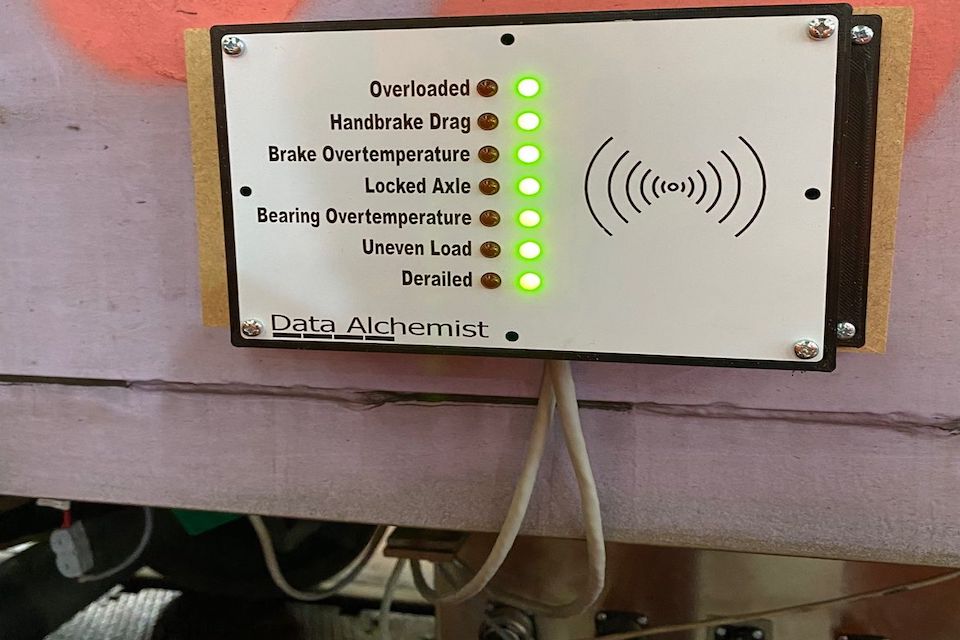A British alternative has been demonstrated to the EU proposed Digital Automatic Coupler (DAC) programme. An examination has been backed by an industry-recognised safety body. The work has been carried out by a nationwide consultancy, and has demonstrated an alternative system. The study found that a cost-effective alternative system of monitoring and real-time reporting could be provided. The system could just as readily address any questions of safety and reliability.
In Europe, proposals have been tabled to fit all rail freight wagons with a uniform ‘Digital Automatic Coupler’. The retrofit would consist of a fixed bar coupler with air, power and data connections. However, the cost of retrofitting the UK fleet with a compliant system has been challenged. A well-received demonstration took place last week, showing that modern-day requirements for an ‘Intelligent Wagon’ could be met without the need to re-engineer every wagon on the rails.
The simplicity of implementation appeals to customers
The cost of adopting the European ‘Digital Automatic Coupler’ has been challenged in the UK. The industry-appointed Rail Safety and Standards Board (RSSB) appointed specialists in Railfreight Consulting to examine the business case. They looked at it in the context of UK rail freight operations. The conclusions from a series of industry workshops was that the industry was not widely in favour of a costly new coupler system. However, Railfreight Consulting found that there was significant interest in the advantages of having enhanced real-time monitoring of what they call an ‘Intelligent Wagon’.
Railfreight Consulting define an Intelligent Wagon (IW) as a vehicle which is able to fault monitor itself and report to train staff and remote observers in real-time. It’s a century removed from the ‘wheel-tapping’ practice of old and has caught the interest of the industry at large. The simplicity of providing a power and data connection appeals to customers, operators, and infrastructure agencies. The step-change improvement in real time fault reporting has caught the imagination. “New technologies simply must happen to drive a step change in safety performance for a generation”, said one industry insider.
Based on proven robust technology
There was a proof of concept demonstration last week at Barrow Hill Innovation Centre in Derbyshire. A rake of goods wagons was put through a rolling demonstration in front of invited guests. Ralph Goldney, the very hands-on managing director of Railfreight Consulting, noted that the national infrastructure agency, Network Rail, was particularly interested. “The Intelligent Wagon system can, for example, address the monitoring of high-risk urban dangerous goods flows, and that is something that could be critical to their response to the safety recommendations following the Llangennech derailment – the oil tanker train that derailed in South Wales in 2020.”

Network Rail provided funding for the proof of concept fitment, shown to the industry last week. The solution demonstrated was based on a single cable which supplies power and communications signals to and from the locomotive cab. It’s a proven technology which is cheaper and may be more robust than an on-wagon wi-fi application powered by wagon axle end generators and/or batteries.
Low-cost and ready-to-implement
“We have proved the Intelligent Wagon concept”, said Ralph Goldney. “The installation on demonstration would not necessarily represent the deployed system, which would need to be more robust. We’ve certainly taken on board issues raised over resilience to operational challenges, but the concept remains the same. There should be a readily accessible wagon fault report, receivable in real-time. At its simplest, that advisory may just be two lights in the cab, one for ‘stop when you can’ and one for ‘stop now’”.
The Intelligent Wagon power and data backbone not only enables significant safety benefits but provides ‘plug and play’ functionality for operational benefits such as handbrake, suspension and brake monitoring. It also enables auto-consisting and is an enabler for ETCS level 3 (European Train Control System standard) on freight trains.
Railfreight Consulting believes a typical solution might cost as little as fifty pounds (58 euros) per wagon per month. That, says Goldney, adds less than one per cent to overall haulage costs. “The implementation of this system mitigates some very significant business risks”, he says. He points to a recent derailment at London Gateway, which denied rail access for over a week. “Prevention is certainly possible of the sort of scenarios that led to the Llangennech derailment and fire. This system is ready to be implemented now as evidenced by the proof of concept.”